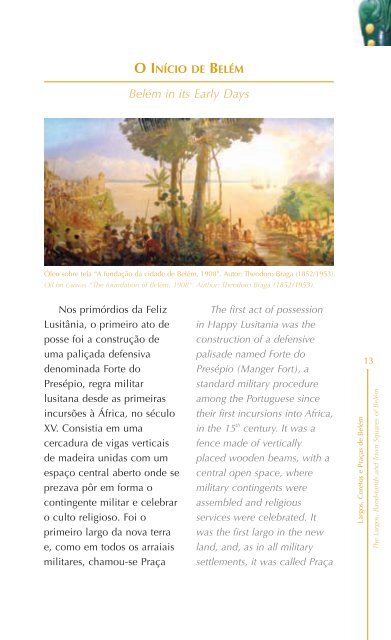LARGOS, CORETOS E PRAÇAS DE BELÉM - Monumenta
LARGOS, CORETOS E PRAÇAS DE BELÉM - Monumenta
LARGOS, CORETOS E PRAÇAS DE BELÉM - Monumenta
You also want an ePaper? Increase the reach of your titles
YUMPU automatically turns print PDFs into web optimized ePapers that Google loves.
Nos primórdios da Feliz<br />
Lusitânia, o primeiro ato de<br />
posse foi a construção de<br />
uma paliçada defensiva<br />
denominada Forte do<br />
Presépio, regra militar<br />
lusitana desde as primeiras<br />
incursões à África, no século<br />
XV. Consistia em uma<br />
cercadura de vigas verticais<br />
de madeira unidas com um<br />
espaço central aberto onde se<br />
prezava pôr em forma o<br />
contingente militar e celebrar<br />
o culto religioso. Foi o<br />
primeiro largo da nova terra<br />
e, como em todos os arraiais<br />
militares, chamou-se Praça<br />
OINÍCIO <strong>DE</strong> <strong>BELÉM</strong><br />
Belém in its Early Days<br />
Óleo sobre tela “A fundação da cidade de Belém, 1908”. Autor: Theodoro Braga (1852/1953).<br />
Oil on canvas “The foundation of Belém, 1908". Author: Theodoro Braga (1852/1953).<br />
The first act of possession<br />
in Happy Lusitania was the<br />
construction of a defensive<br />
palisade named Forte do<br />
Presépio (Manger Fort), a<br />
standard military procedure<br />
among the Portuguese since<br />
their first incursions into Africa,<br />
in the 15 th century. It was a<br />
fence made of vertically<br />
placed wooden beams, with a<br />
central open space, where<br />
military contingents were<br />
assembled and religious<br />
services were celebrated. It<br />
was the first largo in the new<br />
land, and, as in all military<br />
settlements, it was called Praça<br />
Largos, Coretos e Praças de Belém<br />
13<br />
The Largos, Bandstands and Town Squares of Belém













